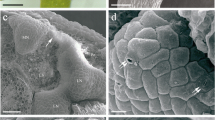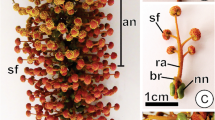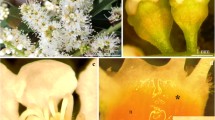Abstract.
Nectar-carbohydrate production and composition were investigated by high-performance liquid chromatography and enzymology in nine species from five tribes of the Brassicaceae. In six species (Arabidopsis thaliana (L.) Heynh., Brassica napus L., B. rapa L., Lobularia maritima (L.) Desv., Raphanus sativus L., Sinapis arvensis L.) that produced nectar from both lateral nectaries (associated with the short stamens) and median nectaries (outside the long stamens), on average 95% of the total nectar carbohydrate was collected from the lateral ones. Nectar from these glands possessed a higher glucose/fructose ratio (usually 1.0–1.2) than that from the median nectaries (0.2–0.9) within the same flower. Comparatively little sucrose was detected in any nectar samples except from Matthiola bicornus (Sibth. et Sm.) DC., which possessed lateral nectaries only and produced a sucrose-dominant exudate. The anatomy of the nectarial tissue in nectar-secreting flowers of six species, Hesperis matronalis L., L. maritima, M. bicornus, R. sativus, S. arvensis, and Sisymbrium loeselii L., was studied by light and scanning-electron microscopy. Phloem alone supplied the nectaries. However, in accordance with their overall nectar-carbohydrate production, the lateral glands received relatively rich quantities of phloem that penetrated far into the glandular tissue, whereas median glands were supplied with phloem that often barely innervated them. All nectarial tissue possessed modified stomata (with the exception of the median glands of S. loeselii, which did not produce nectar); further evidence was gathered to indicate that these structures do not regulate nectar flow by guard-cell movements. The numbers of modified stomata per gland showed no relation to nectar-carbohydrate production. Taken together, the data on nectar biochemistry and nectary anatomy indicate the existence of two distinct nectary types in those Brassicacean species that possess both lateral and median nectaries, regardless of whether nectarial tissue is united around the entire receptacle or not. It is proposed that the term “nectarium” be used to represent collectively the multiple nectaries that can be found in individual flowers.
Similar content being viewed by others
Author information
Authors and Affiliations
Additional information
Received: 21 July 1997 / Accepted: 19 September 1997
Rights and permissions
About this article
Cite this article
Davis, A., Pylatuik, J., Paradis, J. et al. Nectar-carbohydrate production and composition vary in relation to nectary anatomy and location within individual flowers of several species of Brassicaceae. Planta 205, 305–318 (1998). https://doi.org/10.1007/s004250050325
Issue Date:
DOI: https://doi.org/10.1007/s004250050325




